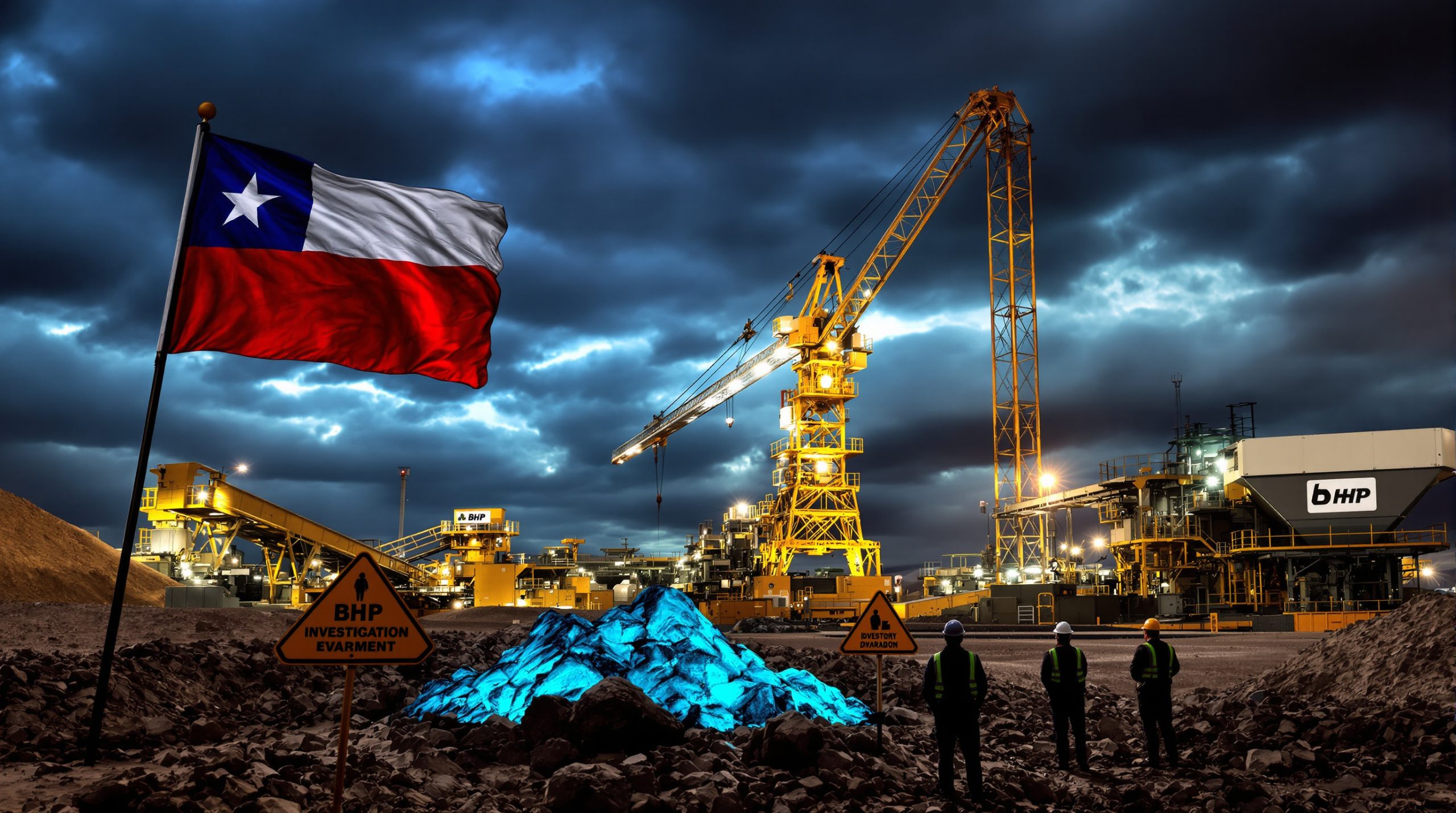Chinese Steel Industry's Strategic Iron Ore Procurement Meeting: What's at Stake?
China's iron ore procurement strategy is poised for potential transformation as the China Iron and Steel Association (CISA) convenes a high-level meeting this week. With iron ore being a critical resource for China's industrial backbone, this gathering could signal shifts in how the world's largest steel producer manages its raw material sourcing. The meeting brings together deputy general managers responsible for iron ore procurement from major Chinese steelmakers, alongside representatives from the state-backed China Mineral Resources Group (CMRG).
What is the Chinese Steel Association's Upcoming Meeting About?
The China Iron and Steel Association has scheduled a critical meeting with iron ore procurement heads from major Chinese steelmakers. According to industry sources familiar with the matter, the meeting will discuss "important work" related to iron ore procurement strategies and market coordination.
The significance of this gathering is underscored by the specific requirement that deputy general managers in charge of iron ore procurement must attend in person. This directive indicates the strategic importance Beijing places on coordinated raw material sourcing for its steel industry.
Key participants will include leadership from China Mineral Resources Group, the state-backed entity established in 2022 specifically to enhance China's bargaining position in global iron ore markets. This collaboration between CISA and CMRG demonstrates the integrated approach China is taking toward resource procurement planning.
Potential Agenda Items
While the official agenda remains undisclosed, industry analysts suggest the meeting will likely address several pressing issues:
- Current iron ore pricing mechanisms and potential collective negotiation strategies
- Supply security concerns amid global market volatility
- Quality requirements for imported ore to meet environmental standards
- Strategic inventory management across the steel sector
The timing of this meeting also suggests preparation for upcoming contract negotiations with major global suppliers, as Chinese steelmakers typically finalize procurement plans for the following quarter during this period.
Why is This Meeting Significant for Global Iron Ore Markets?
Strategic Timing Amid Market Volatility
This meeting comes at a pivotal moment for global iron ore markets. Despite China implementing regulatory-driven steel production cuts, iron ore price trends have shown unexpected resilience. This apparent contradiction highlights the complex dynamics at play between supply constraints, shifting quality requirements, and the ongoing technological transformation of China's steel sector.
The meeting's timing aligns with a period of significant global economic uncertainty, with inflationary pressures, shipping constraints, and geopolitical tensions all impacting resource markets. By coordinating procurement strategies now, Chinese steelmakers may be positioning themselves to better navigate these volatile conditions.
China's Centralized Procurement Strategy
The involvement of China Mineral Resources Group represents a continuation of Beijing's efforts to consolidate iron ore buying power. Since its formation in 2022, CMRG has worked to coordinate procurement activities across China's fragmented steel industry, enhancing the country's collective negotiating leverage with major global suppliers.
This centralized approach marks a significant evolution from the previous model where individual steel companies negotiated separately with international mining giants. By bringing procurement heads together with CMRG leadership, this meeting signals China's commitment to a more cohesive national strategy for critical resource acquisition.
Potential Impact on Price Negotiations
As the world's largest iron ore consumer, accounting for over 70% of seaborne iron ore trade, any coordinated action by Chinese steel producers could significantly influence global pricing mechanisms. The meeting may establish collective bargaining positions ahead of upcoming contract negotiations with major suppliers from Australia and Brazil.
Industry observers note that previous attempts at coordinated procurement have yielded mixed results, but the formal backing of state entities like CMRG provides stronger institutional support for collective action. This enhanced coordination capability could potentially alter the balance of power in price negotiations that have historically favored major suppliers.
How Does China's Steel Industry Structure Influence Iron Ore Procurement?
State-Backed Coordination Framework
China's steel industry operates within a hybrid market system where state guidance intersects with commercial interests. CISA serves as a critical intermediary between government policy objectives and industry implementation, particularly regarding raw material procurement strategies.
This coordination framework allows for strategic alignment across companies that might otherwise compete for resources. The dual participation of CISA and CMRG in this meeting demonstrates how China leverages both industry associations and dedicated state entities to achieve national resource security objectives.
Key elements of this coordination framework include:
- Regular information sharing on pricing trends and supply conditions
- Collective representation in international trade negotiations
- Standardized quality specifications across the industry
- Coordinated timing of major purchase contracts
Balancing Environmental Regulations and Production Needs
Chinese steelmakers face increasingly stringent environmental requirements while maintaining production targets. This dual pressure has shifted procurement priorities toward higher-grade iron ore that can reduce emissions intensity while maintaining output efficiency.
The procurement meeting will likely address how to balance these competing priorities through strategic sourcing decisions. Higher-grade ore typically commands premium pricing but delivers environmental compliance benefits that increasingly justify the additional cost as China pursues its carbon reduction goals.
Domestic vs. Imported Supply Considerations
The meeting may address the balance between domestic iron ore production and imported supplies. China's self-sufficiency efforts have intensified in recent years, though quality and quantity limitations of domestic resources continue to necessitate substantial imports.
Recent developments in domestic mining capacity, particularly in provinces like Hebei and Liaoning, have increased the available supply of Chinese iron ore. However, the relatively low iron content (typically 25-30% compared to 60-65% for imported ores) limits the extent to which domestic sources can replace imports from Australia, Brazil, and other major producers.
What Are the Global Implications of China's Iron Ore Strategy?
Impact on Major Supplier Nations
Australia and Brazil, as the dominant iron ore exporters to China, will closely monitor outcomes from this meeting. Any shift in China's procurement approach could have significant implications for these resource-dependent economies.
Australia, which supplies approximately 60% of China's iron ore imports, has particularly strong exposure to Chinese procurement policies. Major mining companies like Rio Tinto, BHP, and Fortescue Metals Group derive substantial portions of their revenue from Chinese customers and adjust production plans based on anticipated Chinese demand patterns.
Similarly, Brazil's Vale, as the world's largest iron ore producer, relies heavily on Chinese purchases. Any coordinated action to alter procurement volumes, timing, or price negotiation strategies could have material impacts on these companies' operational and financial performance.
Market Transparency and Price Discovery Mechanisms
The centralization of purchasing decisions through entities like CMRG raises questions about market transparency. Global traders and analysts will scrutinize any signals from this meeting regarding China's commitment to market-based price discovery mechanisms.
Previous efforts to influence iron ore pricing structures have included:
- Attempts to shift from spot pricing toward long-term contracts
- Development of China-based iron ore futures markets
- Creation of alternative price benchmarks outside existing index systems
- Coordinated timing of major purchase contracts to influence market sentiment
Industry observers note a potential tension between China's desire for price stability and the functioning of transparent global commodity markets. How this meeting addresses pricing mechanisms will provide important signals about China's approach to international resource markets.
Supply Chain Resilience Considerations
In the post-pandemic environment, supply chain resilience remains a priority for both suppliers and consumers. The meeting may address contingency planning for potential disruptions in global iron ore shipments.
Recent experiences with weather events in Australia, operational challenges in Brazil, and global shipping constraints have highlighted vulnerability in iron ore supply chains. Chinese steelmakers have responded by diversifying supplier relationships beyond the traditional Australia-Brazil duopoly, with growing imports from sources including South Africa, Canada, and various African nations.
How Might This Meeting Affect Steel Production Outlook?
Production Volume Targets
Despite government-mandated production cuts, China's steel output has shown resilience. The procurement meeting could provide insights into expected production volumes for the remainder of 2025 and early 2026, with corresponding implications for iron ore price forecast.
Recent policy directives have emphasized:
- Output restrictions to reduce carbon emissions
- Elimination of outdated production capacity
- Consolidation of production among larger, more efficient producers
- Quality improvements over quantity expansion
These priorities suggest a continued focus on efficiency and environmental performance rather than volume growth, though actual production trends will ultimately be determined by underlying economic conditions and infrastructure development plans.
Quality Requirements and Technological Upgrades
As Chinese steelmakers upgrade facilities to meet environmental standards, their ore quality requirements continue to evolve. The meeting may establish new quality benchmarks or premium structures for preferred ore types.
The ongoing technological transformation of China's steel industry includes:
- Increased deployment of electric arc furnaces (requiring less iron ore)
- More stringent emissions controls on blast furnaces
- Advanced pelletizing and sintering technologies
- Research into hydrogen-based steelmaking
Each of these developments has implications for iron ore procurement, potentially favoring higher-grade materials that enable more efficient and cleaner production processes.
Coordination with Broader Industrial Policy
China's steel production plans align with broader industrial policy objectives, including infrastructure development and manufacturing sector support. The procurement meeting will likely reflect these macro-level priorities.
Major policy initiatives affecting steel demand include:
- Continued urbanization and housing construction
- Transportation infrastructure expansion
- Manufacturing upgrades and automation
- Energy transition projects requiring specialty steel products
By coordinating procurement strategies with these broader economic objectives, Chinese authorities aim to ensure that raw material supplies align with downstream industrial needs.
What Role Does the China Mineral Resources Group Play?
Strategic Coordination Function
Established in 2022, CMRG represents Beijing's effort to consolidate iron ore buying power. Its participation in this meeting underscores the strategic importance of coordinated procurement approaches.
CMRG functions as a central hub for:
- Information sharing across steel producers
- Collective bargaining with international suppliers
- Strategic inventory management
- Long-term supply security planning
This coordination role represents a significant evolution in China's approach to resource procurement, moving from a fragmented model toward more centralized oversight while still maintaining commercial flexibility for individual companies.
Market Intelligence and Pricing Influence
CMRG has developed sophisticated market intelligence capabilities to inform procurement strategies. The meeting may leverage these insights to establish collective positions on pricing and contract terms.
By aggregating data from across China's steel sector, CMRG can identify:
- Optimal timing for major purchase contracts
- Price anomalies or opportunities in different supply regions
- Quality-price relationship trends
- Inventory sufficiency across the industry
These capabilities enable more strategic procurement decisions than would be possible for individual companies operating independently.
Long-Term Supply Security Planning
Beyond immediate procurement concerns, CMRG's mandate includes ensuring long-term supply security. The meeting could address investment in overseas mining assets or strategic partnerships with key suppliers.
China has pursued various approaches to securing long-term iron ore supplies, including:
- Direct investment in mining operations globally
- Infrastructure development in resource-rich countries
- Long-term offtake agreements with emerging producers
- Development of alternative iron sources including recycling
CMRG plays a central role in coordinating these various initiatives into a coherent national strategy for iron ore security.
How Are International Iron Ore Suppliers Responding?
Supplier Diversification Strategies
Major iron ore producers have been diversifying customer bases beyond China while maintaining strong relationships with Chinese buyers. The meeting outcomes may influence these strategic balancing acts.
Leading suppliers are pursuing various approaches including:
- Developing markets in emerging steel-producing nations
- Creating specialized products for different customer segments
- Establishing regional distribution hubs to enhance flexibility
- Investing in processing technologies that add value to raw materials
These strategies reflect recognition that while China remains the dominant market, excessive concentration creates vulnerability for suppliers.
Quality Differentiation and Premium Products
Leading suppliers have increasingly focused on developing premium ore products that command higher prices and meet China's evolving quality requirements. The meeting may signal shifts in these premium structures.
Premium product development has focused on:
- Higher iron content ores (65%+ Fe content)
- Lower impurity levels (particularly silica, alumina, and phosphorus)
- Enhanced physical characteristics for blast furnace efficiency
- Consistent sizing and moisture content
These quality improvements allow suppliers to maintain pricing power even as overall market conditions fluctuate.
Collaborative Decarbonization Initiatives
Several major suppliers have established partnerships with Chinese steelmakers on decarbonization technologies. The procurement meeting could address how these collaborative efforts intersect with commercial relationships.
Joint initiatives include:
- Research into hydrogen reduction of iron ore
- Carbon capture and utilization technologies
- Energy efficiency improvements in ore processing
- Development of direct reduced iron production methods
These collaborations represent a more integrated relationship between suppliers and customers, potentially creating mutual interests beyond traditional buyer-seller dynamics.
What Factors Are Currently Influencing China's Iron Ore Imports?
Inventory Management Practices
Chinese steel mills have adjusted inventory management strategies in response to market volatility. The meeting may establish new guidelines for optimal inventory levels across the industry.
Recent trends in inventory management include:
- More frequent but smaller volume purchases
- Diversification of supply sources for critical grades
- Strategic stockpiling of premium materials
- Coordinated purchasing to avoid market distortions
These practices reflect a more sophisticated approach to managing supply chain risk while optimizing working capital deployment.
Seasonal Demand Patterns
Seasonal factors traditionally influence China's iron ore import volumes. The timing of this meeting suggests preparation for winter production planning and corresponding procurement needs.
Key seasonal factors affecting iron ore procurement include:
- Construction activity cycles and corresponding steel demand
- Winter production restrictions in northern provinces
- Shipping constraints during typhoon season
- Australian wet season impacts on export volumes
By addressing these seasonal patterns collectively, Chinese steelmakers can potentially smooth procurement cycles and reduce market volatility.
Alternative Supply Sources
While Australia and Brazil remain dominant suppliers, China has actively cultivated alternative sources. The meeting could address diversification efforts and their implications for procurement strategies.
Emerging iron ore supply regions of interest include:
- West and Central African nations
- Canada and the United States
- Russia and Central Asia
- Southeast Asian producers
This diversification serves both commercial and strategic objectives, reducing dependence on any single supply region while potentially creating competitive pressure on dominant suppliers.
Market Implications and Future Outlook
The upcoming Chinese steel body iron ore meeting between CISA, Chinese steelmakers' procurement heads, and China Mineral Resources Group represents a significant moment in global iron ore markets. As the world's largest steel producer and iron ore consumer, China's procurement strategies have far-reaching implications for global supply chains, pricing mechanisms, and iron ore market dynamics.
Industry observers will closely monitor any public statements or policy signals emerging from this meeting, particularly regarding volume targets, quality requirements, and pricing approaches. The outcomes could influence not only immediate market conditions but also longer-term structural relationships between iron ore miners spotlight and consumers globally.
Disclaimer: This article contains analysis of potential market developments based on currently available information. Actual outcomes may differ based on policy decisions, market conditions, and other factors. Readers should not make investment or business decisions based solely on this analysis.
As environmental considerations increasingly shape industrial policy in China, the intersection between procurement strategies and decarbonization objectives will likely feature prominently in discussions. This evolving dynamic continues to transform traditional supplier-consumer relationships in the iron ore market.
China's approach to iron ore procurement represents a critical case study in how resource-dependent economies can leverage institutional coordination to enhance market position. Whether these efforts ultimately reshape global commodity markets or simply optimize China's position within existing structures remains to be seen, but the strategic significance of this Chinese steel body iron ore meeting should not be underestimated. Concerns about iron ore price decline in the coming months could also be a key point of discussion as stakeholders prepare for potential market shifts.
Want to Stay Ahead of Major Mineral Discoveries?
Discovery Alert's proprietary Discovery IQ model instantly identifies significant ASX mining announcements, providing real-time alerts on potential investment opportunities before the broader market reacts. Explore why major mineral discoveries can generate substantial returns by visiting the dedicated discoveries page and begin your 30-day free trial today.




